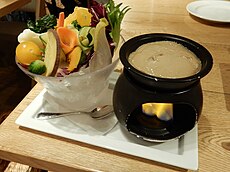Bagna càuda
 Bagna càudais kept hot by a small heat source below the dish. | |
| Type | Dipping sauce |
|---|---|
| Region or state | |
| Main ingredients | Garlic,anchovies,olive oil |
Bagna[1]càuda(Piedmontese:[ˈbɑɲɐˈkɑʊ̯dɐ];lit. 'hot dip'or'hot gravy'), also spelledbagna caouda[2]inAlpes-Maritimes,is a hot dish made withgarlicandanchovies,typical ofLower Piedmont,a geographical region ofPiedmont,Italy,[3][4]andProvence,France. The dish is served and consumed in a manner similar tofondue,sometimes as anappetizer,with raw or cooked vegetables typically used to dip into it.[5]
Overview[edit]
Bagna càudais a hot dish anddipping saucein Piedmontese and Provençal cuisine that is used to dip vegetables in.[6][7]It is prepared using olive oil, chopped anchovies and garlic.[6][7]Additional ingredients sometimes used include truffle and salt.[6]Raw or cooked vegetables are dipped into the sauce, which is typically kept hot on a serving table using a heat source such as a candle or burner.[6]
Cardoon(edible thistle) is often dipped in the sauce.[6]Additional foods used to dip into it includecabbage,celery,carrot,Jerusalem artichoke,pepper,fennel,and bread.[6][8]It is sometimes served as anappetizer.[9][10]
In the past,walnutorhazelnutoil would have been used.[11]Sometimes,trufflesare used in versions around the Italiancomune(municipality) ofAlba,in the Piedmont region.[12]It is traditionally eaten during the autumn and winter months, particularly at Christmas and New Year's, and must be served hot, as the name suggests.
Consumption in North and South America[edit]
It is also a popular winter dish in centralArgentina[13][14]and prevalent in Clinton, Indiana; Rock Springs, Wyoming; and Benld, Illinois;[15]as there were many northern Italian immigrants to those places.[16]Bagna càudawas also prepared in the coal-mining community of Madison County, Illinois[17](including Collinsville,[18]Edwardsville and Maryville), due to the numerous Italian immigrants that came there to work in the mines.

History[edit]
This articleneeds additional citations forverification.(August 2023) |
Bagna càudahas been a part of Piedmontese cuisine since the 16th century.[6][19]The recipe is typical ofLower Piedmont,a geographical region ofPiedmont,Italy, as in past centuries in that area it was very easy to obtain the saltedanchovy,the fundamental ingredient, still used today in many typical Piedmontese recipes, especially amongappetizers,for example, theanciove albagnet verdoralbagnèt ross.Ancient Piedmont obtained its salt from thesalineofProvenceand the mouths of the Rhône, through a series of commercial routes crossing the passes of theMaritime Alpsand known as "salt roads"; in fact at the timeNiceand its surroundings were territorySavoyard.Legend has it that the trade in salted anchovies was a way to tradesalt,thus avoiding paying the high duties: tubs full of salt presented a layer of salted anchovies in the upper part to the control of the tax collectors. In reality, throughout the Piedmont of the old regime, the saltgabellewas a compulsory tax and not linked to consumption. Not only that, salted anchovies were much more expensive and their price was sustainable only in relation to the modest purchase quantities. The "anchovy seller" (ancióaireinPiedmontese language) was the itinerant merchant who with the typical cart pulled by horses or oxen brought the anchovies in barrels and wooden casks.
Thebagna càudawas rejected for a long time by the wealthier classes, who considered it a coarse food and unsuitable for a refined diet, in particular, due to the presence of garlic and the effects of its intake on the breath, where it remains for a considerable time (in some cases even up to twenty-four hours). For this reason, written information about this dish is rather rare in Piedmontese gastronomic texts. The first detailed description of thebagna càudain its current version is due toRoberto Sacchettiand dates back to 1875.[20]
Similar dishes[edit]
Pinzimoniois a similardipping sauceprepared using olive oil, salt, pepper and occasionally wine vinegar, which is served with raw vegetables[19][21]and is typically served cold.[22]
Anchoïadeis a similar dish served in France.[citation needed]
See also[edit]
![]() Media related toBagna càudaat Wikimedia Commons
Media related toBagna càudaat Wikimedia Commons
![]() The dictionary definition ofbagna càudaat Wiktionary
The dictionary definition ofbagna càudaat Wiktionary
References[edit]
- ^"bagna".Grande Dizionario Piemontese Olivetti.Retrieved24 January2021.
- ^Ducasse, Alain (2009-11-13).Gran libro de cocina de Alain Ducasse. Mediterráneo(in Spanish). Ediciones AKAL.ISBN978-84-460-2327-2.
- ^Howell, Francesca Ciancimino (2018-08-09).Food, Festival and Religion: Materiality and Place in Italy.Bloomsbury Publishing.ISBN978-1-350-02087-0.
- ^Machado, Amparo; Prete, Chiara (2015-09-24).1001 specialità della cucina italiana da provare almeno una volta nella vita(in Italian). Newton Compton Editori.ISBN978-88-541-8648-4.
- ^La Cucina Italiana2008,s.v.
- ^abcdefgRoot, W. (1992).The Food of Italy.Vintage Books. pp. 319–320.ISBN978-0-679-73896-1.RetrievedJanuary 4,2018.
- ^abSinclair, C.G. (1998).International Dictionary of Food and Cooking.Fitzroy Dearborn. p. 44.ISBN978-1-57958-057-5.RetrievedJanuary 4,2018.
- ^Los Angeles Magazine.2008. p. 114.RetrievedJanuary 4,2018.
- ^Buckley, Chris (November 27, 2012)."Iconic Charleroi eatery – Rego's – changes hands".TribLIVE.com.RetrievedJanuary 4,2018.
- ^Waters, A.L. (2014).Chez Panisse Cafe Cookbook(in French). HarperCollins. p. 16.ISBN978-0-06-235400-6.RetrievedJanuary 4,2018.
- ^Paolo Massobrio,‘Il rito della Bagnacauda’ArchivedJuly 22, 2011, at theWayback Machine,a+,December 2004.
- ^Hesser, Amanda (November 5, 2009)."Bagna Cauda, 1960".New York Times.p. MM20, New York edition.RetrievedMarch 8,2010.
- ^McCloskey, E.; Ainsley, R.; Eder, T. (2011).Argentina: The Bradt Travel Guide.Bradt Guides. Bradt Travel Guides. p. 388.ISBN978-1-84162-351-1.RetrievedJanuary 4,2018.
- ^Books, Madison; Andrews McMeel Publishing, LLC; Kummer, C. (2007).1001 Foods To Die For(in German). Andrews McMeel Publishing. p.16.ISBN978-0-7407-7043-2.RetrievedJanuary 4,2018.
- ^Zelinsky, Wilbur (2001).The Enigma of Ethnicity: Another American Dilemma.NONE Series. University of Iowa Press. p.120.ISBN978-1-58729-339-9.RetrievedJanuary 4,2018.
- ^Calvitto, C. (2007).Searching for Italy in America's Rural Heartland.Vantage Press. p. 2.ISBN978-0-533-15737-2.RetrievedJanuary 4,2018.
- ^Hillig, Terry.Miners’ heritage is on display in Collinsville.St. Louis Post-Dispatch. September 22, 2010. Retrieved July 28, 2021.
- ^Starkey, Roger.Collinsville Sunrise Kiwanis: Selling bagna cauda and peanuts for a better Christmas.The Metro Independent. September 12, 2014. Retrieved July 28, 2021.
- ^abWestern Pennsylvania History.Historical Society of Western Pennsylvania. 1999. p. 167.RetrievedJanuary 4,2018.
- ^Piedmont (16 November 2018)."La Bagna Caòda"(PDF).Archived fromthe original(PDF)on 4 November 2014.
- ^Darrow, D.; Maresca, T. (2012).The Seasons of the Italian Kitchen.Grove/Atlantic, Incorporated. p. pt185.ISBN978-0-8021-9341-4.RetrievedJanuary 4,2018.
- ^Vivian, C.; Sansone, V.P. (2011).Tuscan-American Kitchen, A(in German). Pelican Pub. Company. p. 93.ISBN978-1-58980-906-2.RetrievedJanuary 4,2018.
